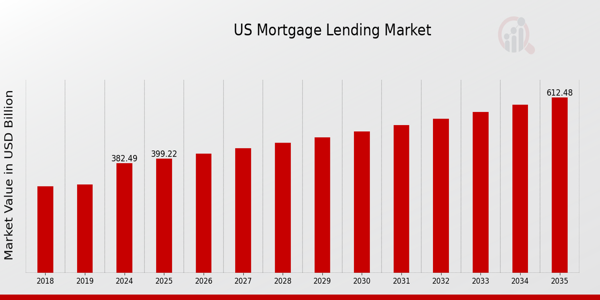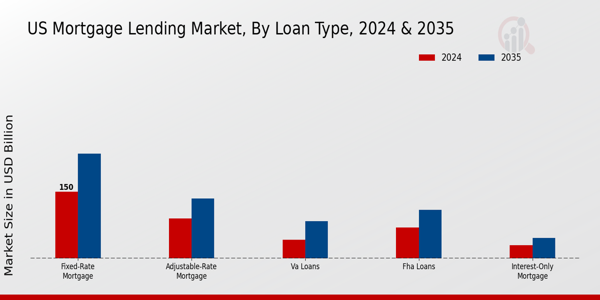US Mortgage Lending Market Overview
As per MRFR analysis, the US Mortgage Lending Market Size was estimated at 366.44 (USD Billion) in 2023. The US Mortgage Lending Market is expected to grow from 382.49 (USD Billion) in 2024 to 612.5 (USD Billion) by 2035. The US Mortgage Lending Market CAGR (growth rate) is expected to be around 4.373% during the forecast period (2025 - 2035).
Key US Mortgage Lending Market Trends Highlighted
Numerous variables are driving notable trends in the US mortgage lending market at the moment. The sustained low interest rate environment, which has enticed consumers to get mortgages at advantageous terms, is one important market driver. The U.S. Federal Reserve's monetary policies, which are designed to stimulate economic activity, especially after economic disasters, support this atmosphere.
Alternative mortgage products, such adjustable-rate mortgages and government-backed loans, are becoming more and more popular as Americans continue to worry about the affordability of housing. As lenders make technological investments to expedite the application and approval processes, recent trends also point to an increase in digital mortgage options.
With more borrowers choosing online platforms, customer desires for speed and convenience are driving this shift towards automation. A noticeable trend towards sustainability is also evident, as lenders are providing green mortgage packages that encourage energy-efficient homes more frequently. This reflects American homeowners' increased consciousness of environmental issues.
Additionally, fresh opportunities are presented by the demographic change toward younger generations entering the housing market. The growing interest in homeownership among Millennials and Generation Z has prompted innovative marketing strategies and loan servicing strategies catered to their particular requirements.
In addition to the growing popularity of remote work, there is a migratory tendency toward suburban and rural areas, which has an effect on regional lending practices and housing markets. As a result, these changing patterns and factors influence the US mortgage lending market, posing opportunities as well as problems to lenders in the present environment.

Source: Primary Research, Secondary Research, Market Research Future Database and Analyst Review
US Mortgage Lending Market Drivers
Growing Demand for Housing
The demand for housing in the United States continues to rise due to population growth and urbanization, driving the US Mortgage Lending Market. According to the United States Census Bureau, the U.S. population is projected to grow significantly, which translates into an increase in household formation.
In the last decade, the U.S. has seen an increase of over 7 million households formed, and this number is expected to grow in the coming years.
Furthermore, the National Association of Realtors reported that the existing home sales reached approximately 5.64 million in the past year, establishing a strong need for mortgage financing. This ongoing demand for housing solutions propels mortgage lending institutions to adapt their offerings, further enhancing the overall US Mortgage Lending Market.
Low Interest Rates
Historically low interest rates in the United States have been a key driver in stimulating the US Mortgage Lending Market. The Federal Reserve's monetary policy has maintained low benchmark interest rates to support economic recovery and encourage borrowing.
As of recent reports, mortgage rates have dropped to record lows, with the average 30-year fixed mortgage rate dipping below 3%. This has led to increased refinancing activities and new mortgage applications.
The Mortgage Bankers Association indicated that the refinancing share of mortgage activity has surged by nearly 60% amid the favorable rate environment. Such circumstances not only boost borrowing but also facilitate home buying, thereby expanding the US Mortgage Lending Market.
Technological Advancements in Mortgage Solutions
The integration of technology in the US Mortgage Lending Market is transforming the way lenders and borrowers interact, leading to streamlined processes and enhanced customer experience. Mortgage technology firms are innovating solutions such as digital mortgages and e-signatures, which drastically reduce processing time.
A report by the American Bankers Association indicates that over 70% of banks are investing in technological advancements to improve lending services.
This shift toward digital solutions has resulted in a reduction of loan processing times by up to 50%, making the lending process more accessible to consumers. Such progress is crucial in meeting the growing demand for mortgage products and contributes significantly to market expansion.
Increased Regulatory Support
The regulatory framework surrounding mortgage lending in the United States has evolved to promote responsible lending practices, thus enhancing trust and stability in the US Mortgage Lending Market. Recent changes, spearheaded by the Consumer Financial Protection Bureau, focus on borrower protections and transparency in the lending process.
These regulations are seen as beneficial in improving the overall quality of mortgage products available to consumers.
For instance, the qualified mortgage rule sets clear standards that lenders must follow, enhancing consumer confidence in the borrowing process. Additionally, this regulatory support is fostering a competitive marketplace, helping to mitigate risks and encouraging more consumers to enter the housing market.
US Mortgage Lending Market Segment Insights
Mortgage Lending Market Loan Type Insights
The Loan Type segment of the US Mortgage Lending Market plays a crucial role in shaping the landscape of home financing options available to consumers. The market offers various types of loans tailored to different borrower needs, such as Fixed-Rate Mortgages, Adjustable-Rate Mortgages, Interest-Only Mortgages, FHA Loans, and VA Loans.
Fixed-Rate Mortgages remain particularly popular due to their stability; borrowers appreciate the predictability of fixed monthly payments over the loan term, making them an appealing choice for first-time homebuyers and those looking for long-term financial security.
On the other hand, Adjustable-Rate Mortgages feature lower initial interest rates that can provide significant savings for borrowers during the early years of the loan. However, these loans can pose risks if interest rates rise, creating a unique trade-off that some homeowners are willing to accept for potential financial benefits.
Interest-Only Mortgages allow borrowers to pay only interest for a specified period, thus maximizing cash flow during the early years of homeownership. This option may attract investors or those anticipating rising incomes, but it does come with the challenge of larger payments down the line when both principal and interest become due.
FHA Loans, backed by the Federal Housing Administration, are designed primarily for low-to-moderate-income borrowers who may have lower credit scores or less savings for a down payment. This segment significantly enhances access to homeownership, thereby expanding the pool of eligible buyers in the market.
VA Loans, reserved for veterans and active-duty military members, offer compelling benefits such as no down payments and favorable terms, making them a significant component of the financing landscape for those who have served the nation.
The interplay of these loan types reflects broader trends in the US mortgage industry, shaped by economic conditions, consumer preferences, and government policies. Key growth drivers for the Loan Type segment include the ongoing demand for affordable housing, shifts in demographic trends, and increasing awareness of various financing options.
However, challenges do exist, such as rising interest rates and housing supply constraints that can affect borrower access to these loan types. Overall, the Loan Type segment contributes significantly to the US Mortgage Lending Market, offering diverse opportunities for both borrowers and lenders while responding to the evolving landscape of home financing in the region.

Source: Primary Research, Secondary Research, Market Research Future Database and Analyst Review
Mortgage Lending Market Lending Institution Insights
The Lending Institution segment within the US Mortgage Lending Market is a pivotal component driving market growth, reflecting diverse approaches to mortgage financing. This segment houses various entities, such as banks, credit unions, mortgage companies, and online lenders, each contributing uniquely to the lending landscape.
Banks typically dominate the market due to their extensive resources, established customer bases, and regulatory support. Credit unions offer competitive rates and personalized service, appealing to a niche market that values community-centric banking.
Mortgage companies, specializing in home loans, play a crucial role in facilitating access to competitive financing options. Meanwhile, online lenders have surged in popularity, leveraging technology to streamline the mortgage application process and cater to a tech-savvy demographic.
The continuous evolution of digital financing solutions is transforming the traditional lending practices, making them more accessible and efficient.
Understanding these dynamics within the Lending Institution segment is essential, as it reflects the broader trends of the US Mortgage Lending Market, which is anticipated to witness sustained growth fueled by favorable interest rates and increasing housing demand.
The segmentation of the market also highlights the varying customer preferences and the adaptability of institutions in meeting these needs, underlining the importance of innovation and customer service in maintaining a competitive edge.
Mortgage Lending Market Borrower Type Insights
The Borrower Type segment of the US Mortgage Lending Market plays a critical role in shaping lending dynamics across the country. Within this segment, First-Time Homebuyers have consistently been a driving force, often benefiting from various state and federal assistance programs aimed at facilitating homeownership.
Move-Up Buyers, who sell their existing homes to purchase larger or more desirable properties, contribute significantly to market fluidity, thus enabling more homes to be available for First-Time Homebuyers. Investors, on the other hand, are increasingly prominent in the market as they see rental property as a lucrative opportunity, influencing housing prices and availability.
Refiners, those who refinance existing mortgages to take advantage of lower rates or to enhance financial stability, also play a key role in market trends, often helping to stabilize lending practices and rates. Overall, understanding these borrower types is essential as they directly influence the US Mortgage Lending Market statistics and dynamics while presenting both opportunities and challenges for lenders aimed at tailoring products to meet unique borrower needs.
Mortgage Lending Market Property Type Insights
The US Mortgage Lending Market showcases a diverse segmentation centered around Property Type, which includes Residential, Commercial, Industrial, and Land. The Residential sector is vital, reflecting a substantial portion of the market, driven by the high demand for housing due to population growth and urbanization trends.
Conversely, the Commercial segment benefits from the ongoing expansion of e-commerce and businesses requiring physical spaces, further emphasizing its importance in the overall market landscape. The Industrial segment has gained traction as supply chains evolve, necessitating warehouses and distribution centers, which enhances its significance in the current economic climate.
Lastly, the Land segment plays a crucial role for potential real estate development, particularly in growing suburban areas, enabling investors to capitalize on future growth.
These segments collectively underscore the varying dynamics and opportunities present within the US Mortgage Lending Market, thereby positioning stakeholders to navigate specific sector challenges and capitalize on market growth effectively. The overall market is impacted by trends such as rising interest rates and regulatory changes, which create both challenges and opportunities for each property type.
US Mortgage Lending Market Key Players and Competitive Insights
The US Mortgage Lending Market is characterized by a diverse landscape of participants, ranging from large national banks to specialized mortgage lenders. This market has evolved significantly over the years, heavily influenced by economic factors such as interest rates, housing demand, and regulatory changes.
Competition in this sector is intense as companies strive to capture market share by offering innovative loan products, competitive pricing, and superior customer service. The emergence of technology has also transformed the way mortgage lending operates, leading to digitized processes that enhance efficiency and accessibility for borrowers.
Competitors are continuously adapting to shifts in consumer preferences and economic conditions, focusing on providing personalized solutions that meet the varied needs of homebuyers and homeowners.
Guild Mortgage operates as a prominent player in the US Mortgage Lending Market with a comprehensive suite of mortgage products tailored to meet the needs of various customers. The company offers conventional, FHA, VA, and USDA loans, ensuring that it addresses different segments of the home financing market.
Guild Mortgage has established a strong market presence by emphasizing community involvement and personalized service, which allows it to foster trust and long-lasting relationships with clients. The company has also pursued strategic growth through mergers and acquisitions, enhancing its footprint across different states.
Guild Mortgage’s dedication to meeting diverse customer needs, along with its regional expertise, empowers it to efficiently navigate the competitive landscape of mortgage lending in the US. Its strengths also include robust technology solutions that facilitate the borrowing process, thus appealing to a broad range of potential clients.
Key Companies in the US Mortgage Lending Market Include
- Guild Mortgage
- Wells Fargo
- Bank of America
- Quicken Loans
- United Wholesale Mortgage
- loanDepot
- Caliber Home Loans
- JPMorgan Chase
- Citigroup
- PNC Financial Services
US Mortgage Lending Market Developments
Wells Fargo & Co. stated in March 2025 that the Federal Reserve had withdrawn two long-standing enforcement actions against the company for its foreclosure and mortgage servicing practices. The company also reaffirmed that the asset cap that was put in place in 2018 is still in place, though it is getting close to being approved for removal by the middle of 2025.
Wells Fargo economists warned buyers not to expect a recovery to sub-6 percent levels observed prior to the pandemic in July 2025, predicting that 30-year fixed mortgage rates would stay high at roughly 6.9 percent through 2025 and only slightly decline to 6.5 percent in 2026.
With strong total revenue growth of roughly 8% year over year in Q1 2025, JPMorgan Chase maintained its position as one of the leading domestic mortgage originators and solidified its leadership in both retail and commercial loan activity.
Bank of America and Citigroup, on the other hand, experienced a decrease in mortgage production in Q1 2025 compared to Q4 2024; BofA originated about $4.5 billion in first-lien home loans, which was down about 31.5 percent from quarter to quarter but up more than 30 percent from year to year.
Citi also experienced similar seasonal declines and expressed uncertainty about the future due to trade tensions and macroeconomic headwinds.
Mortgage Lending Market Segmentation Insights
-
Mortgage Lending Market Loan Type Outlook
- Fixed-Rate Mortgage
- Adjustable-Rate Mortgage
- Interest-Only Mortgage
- FHA Loans
- VA Loans
-
Mortgage Lending Market Lending Institution Outlook
- Banks
- Credit Unions
- Mortgage Companies
- Online Lenders
-
Mortgage Lending Market Borrower Type Outlook
- First-Time Homebuyers
- Move-Up Buyers
- Investors
- Refiners
-
Mortgage Lending Market Property Type Outlook
- Residential
- Commercial
- Industrial
- Land
| Report Attribute/Metric |
Details |
| Market Size 2023 |
366.44(USD Billion) |
| Market Size 2024 |
382.49(USD Billion) |
| Market Size 2035 |
612.5(USD Billion) |
| Compound Annual Growth Rate (CAGR) |
4.373% (2025 - 2035) |
| Report Coverage |
Revenue Forecast, Competitive Landscape, Growth Factors, and Trends |
| Base Year |
2024 |
| Market Forecast Period |
2025 - 2035 |
| Historical Data |
2019 - 2024 |
| Market Forecast Units |
USD Billion |
| Key Companies Profiled |
Guild Mortgage, Wells Fargo, Bank of America, Quicken Loans, United Wholesale Mortgage, loanDepot, Caliber Home Loans, JPMorgan Chase, Citigroup, PNC Financial Services |
| Segments Covered |
Loan Type, Lending Institution, Borrower Type, Property Type |
| Key Market Opportunities |
Digital mortgage solutions, Sustainable lending alternatives, Home equity line growth, First-time homebuyer programs, Enhanced credit scoring models |
| Key Market Dynamics |
Interest rate fluctuations, Regulatory changes, Housing supply shortages, Consumer credit trends, Technological advancements |
| Countries Covered |
US |
Frequently Asked Questions (FAQ):
The US Mortgage Lending Market was valued at 382.49 billion USD in 2024.
By 2035, the market size of the US Mortgage Lending Market is projected to reach around 612.5 billion USD.
The expected CAGR for the US Mortgage Lending Market from 2025 to 2035 is approximately 4.373%.
The Fixed-Rate Mortgage segment was the largest, valued at 150.0 billion USD in 2024.
FHA Loans are expected to reach a value of 110.0 billion USD by 2035.
Major players in the market include Wells Fargo, Bank of America, and Quicken Loans, among others.
The market value for Adjustable-Rate Mortgages was around 90.0 billion USD in 2024.
The market presents challenges such as rising interest rates and opportunities including increased demand for affordable housing.
VA Loans are anticipated to reach a value of approximately 84.3 billion USD by 2035.
Emerging trends include digital mortgage solutions and a growing focus on customer-centric services.
















